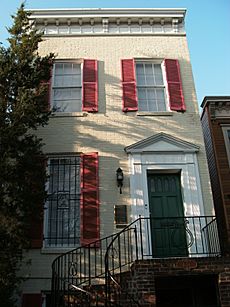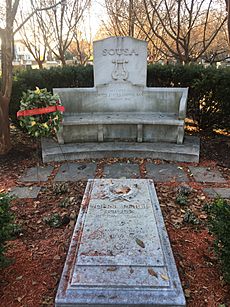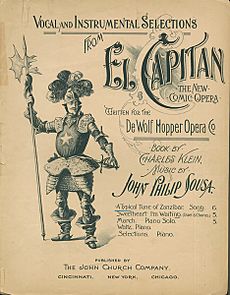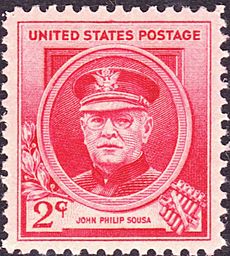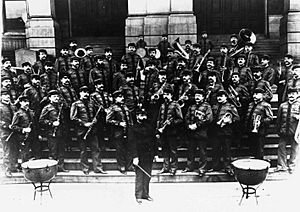John Philip Sousa facts for kids
Quick facts for kids
John Philip Sousa
|
|
|---|---|
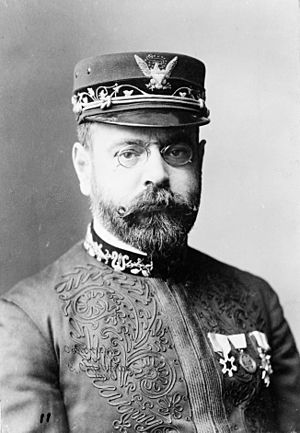
Sousa in 1900; photo by Elmer Chickering
|
|
| Born | November 6, 1854 Washington, D.C., U.S.
|
| Died | March 6, 1932 (aged 77) Reading, Pennsylvania, U.S.
|
| Burial place | Congressional Cemetery |
| Other names | "The (American) March King" |
| Known for |
|
|
Notable work
|
Full list |
| Spouse(s) |
Jane van Middlesworth Bellis
(m. 1879) |
| Children | 3 |
| Military career | |
| Allegiance | United States |
| Service/ |
|
| Years of service |
|
| Rank |
|
| Commands held |
|
| Signature | |
John Philip Sousa (pronounced SOO-zə or SOO-sə; born November 6, 1854 – died March 6, 1932) was an American composer and conductor. He lived during the late 1800s and early 1900s. Sousa is best known for his exciting American military marches. People often called him "The March King" because he wrote so many famous marches.
Some of his most well-known marches include "The Stars and Stripes Forever" (which is the official national march of the United States of America), "Semper Fidelis" (the official march of the United States Marine Corps), "The Liberty Bell", "The Thunderer", and "The Washington Post".
Contents
Early Life and Music Training
John Philip Sousa was born in Washington, D.C.. He was the third of ten children. His father, John Anthony Sousa, was born in Spain to Portuguese parents. His mother, Maria Elisabeth Trinkhaus, was German.
Learning Music
John Philip Sousa started his music lessons with John Esputa Sr. He learned solfeggio, which is a way to learn music notes by singing them. But this teacher had a bad temper, so the lessons didn't last long.
Sousa's real music education began around 1861 or 1862. He became a student of John Esputa Jr., the son of his first teacher. Sousa studied many instruments, including the violin, piano, flute, and brass instruments. He also learned to sing. Even though this teacher also had a bad temper, Sousa learned very quickly. He was found to have perfect pitch, meaning he could identify any musical note just by hearing it. During this time, Sousa wrote his first song, "An Album Leaf," but it was later lost.
A Career in Music
Sousa's father was a trombone player in the Marine Band. To stop John Philip from joining a circus band, his father enlisted him in the United States Marine Corps as an apprentice when he was just 13 years old. Sousa also started studying music with George Felix Benkert that same year. Because he was so young, he was set to stay in the Marine Corps until he turned 21.
Sousa left the Marine Band in 1875. For the next five years, he played the violin and learned how to conduct music.
In 1880, he returned to the Marine Band and became its director. He led the band for 12 years. After that, Sousa was hired to lead his own band, which was put together by David Blakely.
From 1880 until he passed away, Sousa spent all his time conducting and writing music. He also helped create the sousaphone. This is a large brass instrument that looks like a tuba and is often used in marching bands.
When World War I began, Sousa was given a special military rank of lieutenant commander. He led the Naval Reserve Band in Illinois. After the war, he went back to conducting the Sousa Band until he died in 1932. In the 1920s, Sousa was given the permanent rank of lieutenant commander in the naval reserve.
Sousa's Compositions
John Philip Sousa wrote a lot of music! He composed over 130 marches. He also wrote 15 operettas (which are like light operas with singing and speaking), 5 overtures (musical introductions), and many other pieces.
He wrote marches for several American universities. These include the University of Minnesota, University of Illinois, University of Nebraska, and the University of Michigan.
Sousa also wrote the music for six operettas that were never finished or performed. He even wrote a march based on songs from the famous comic opera The Mikado. He often included music by other composers, like Sullivan, in his concerts.
Sousa once said, "My religion lies in my composition." This shows how much music meant to him.
Personal Life
On December 30, 1879, John Philip Sousa married Jane van Middlesworth Bellis. They had three children together: John Philip Jr., Jane Priscilla, and Helen.
Hobbies and Other Interests
Besides music, Sousa was a very good trapshooter. This is a sport where you shoot at clay targets thrown into the air. He was so good that he was put into the Trapshooting Hall of Fame! He even helped start the first national trapshooting organization. Sousa also wrote many articles about trapshooting.
Sousa also enjoyed writing stories. In 1902, he wrote a short novel called The Fifth String. It was about a violinist who gets a magic violin with five strings. The fifth string, however, brings death if played. He also wrote Pipetown Sandy in 1905 and a longer story called "The Transit of Venus" in 1920.
He also wrote a guide called "A manual for trumpet and drum." It gave advice for playing these instruments. An early version of the trumpet solo from "Semper Fidelis" was in this book.
Later Years and Death
In his later years, Sousa lived in Sands Point, New York.
He passed away from heart failure on March 6, 1932, at the age of 77. He died in a hotel room in Reading, Pennsylvania. John Philip Sousa is buried in Washington, D.C., at the Congressional Cemetery. Every year on November 6, the Marine Band plays "Semper Fidelis" at his grave.
His home, Wildbank, is a special historical landmark. It is still a private home and not open to the public.
Interesting Facts About John Philip Sousa
- The Sousaphone is a special instrument named after him. It was created in 1893 by instrument maker J. W. Pepper, using some of Sousa's ideas.
- Sousa was a Freemason. He joined the Hiram Lodge No. 10 in Washington, D.C., in 1881. He was an active member until he died.
- He was also an honorary band leader for the Temple Band of Almas Shriners. He wrote some music for this group, including the "Nobles of the Mystic Shrine" March.
- Sousa was a member of several other groups, including the Sons of the Revolution and the American Legion.
- He loved trapshooting and often competed for the Navy against the Army. Records show he shot at more than 35,000 targets in his life!
- Sousa didn't like early music recordings. He called them "canned music." He usually didn't conduct his band when they were being recorded.
- He has family members alive today. One of his great-grandsons, John Philip Sousa IV, is a political activist.
Honors and Awards
John Philip Sousa received many honors during his life and even after his death:
- He was given special awards from Portugal and France for his work in public education.
- In 1901, King Edward VII of the United Kingdom gave him the Royal Victorian Medal. This was for conducting a private concert for Queen Alexandra.
- In 1922, he became an honorary member of Kappa Kappa Psi, a national band fraternity.
- In 1932, he became an honorary member of Phi Mu Alpha Sinfonia, a national music fraternity.
- A World War II ship, the SS John Philip Sousa, was named in his honor. The Marine Band uses the ship's bell when they play the "Liberty Bell March."
- In 1952, a movie called Stars and Stripes Forever was made about his life. Clifton Webb played Sousa in the film.
- In 1987, the U.S. Congress officially named "The Stars and Stripes Forever" as the national march of the United States.
- In 2012, a crater on the planet Mercury was named after him.
- In 1976, he was added to the Hall of Fame for Great Americans.
John Philip Sousa Award
Even after his death, John Philip Sousa is remembered as "The March King." The John Philip Sousa Foundation is a non-profit group started in 1981. It gives awards and scholarships to talented music students. They recognize students in marching band for their musical skills, reliability, loyalty, and teamwork. The foundation also supports projects like The Sudler Trophy and The Sudler Shield.
List of Compositions
Marches
Sousa wrote over 130 marches. Some of his most famous ones include:
- "The Gladiator March" (1886)
- "Semper Fidelis" (1888) (Official March of the United States Marine Corps)
- "The Washington Post" (1889)
- "The Thunderer" (1889)
- "High School Cadets" (1890)
- "The Liberty Bell" (1893) (used in the TV show Monty Python's Flying Circus)
- "King Cotton" (1895)
- "Stars and Stripes Forever" (1896) (National March of the United States)
- "El Capitan" (1896)
- "Hands Across the Sea" (1899)
- "Invincible Eagle" (1901)
- "Fairest of the Fair" (1908)
- "U.S. Field Artillery" (1917) (a modified version is the official song of the U.S. Army)
- "The Gallant Seventh" (1922)
- "Nobles of the Mystic Shrine" (1923)
- "The Black Horse Troop" (1924)
- "Minnesota March" (1927)
Operettas
Sousa wrote several notable operettas, which are like light musical plays:
- Désirée (1883)
- El Capitan (1896)
- The Charlatan (1898), also known as The Mystical Miss
- Chris and the Wonderful Lamp (1899)
See also
 In Spanish: John Philip Sousa para niños
In Spanish: John Philip Sousa para niños
- Sousa Archives and Center for American Music
- John Philip Sousa Bridge
- Patrick Gilmore


